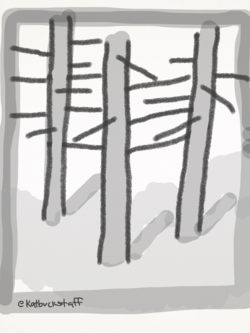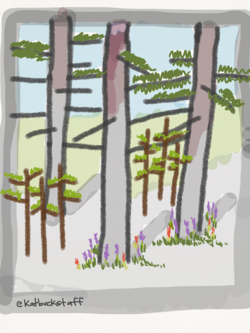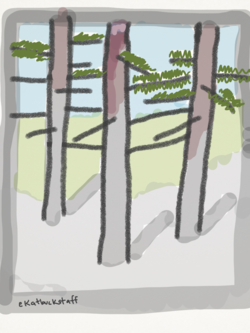While on my first backpacking trip, my husband and I walked through an old growth forest in Yosemite that had been badly burned. With my hat on and my eyes focused downward on the trail, I could see only fire damaged tree trunks -- black, scalded, fried, singed, tree after tree after tree.
So much had been destroyed. Death was everywhere, and I felt the burn in my heart.
Dan and I walked in silence. When I looked out, I saw tall silhouettes that used to be trees.
I felt quiet and reflective. I felt my body ache with pain. It was as if every burn in my own life was on display in the forest. Grief overwhelmed me.
Dan, who has hiked through burned forests before, told me as we headed into the wilderness, "The toughest part about Yosemite for me is seeing the burned trees. I worked hard to find a philosophy to deal with them."
As we walked, Dan kept a steady pace, obviously supported by his found philosophy, but I was a rookie at hiking and particularly at hiking through a burned area. I slowed down. After awhile, I couldn't move.
Some loss can feel this decimating, and it is.
Dan sensed my sadness, stopped and said, "Look up."
The fire had been hot; the damage extensive. My eyes filled with tears.
"Look up," Dan said again.
When I looked up, I saw green pine needles on healthy branches that reached upward from scalded trunks.
"Many of the burned trees are still alive," I said.
The 200-foot tall Ponderosa Pines had learned a few things about how to survive fire. In addition to being tall, many were 100s of years old.
Dan explained to me that their thick bark saved them.
Right then, I wanted to dress myself in Ponderosa Pine bark. It protects the sap inside allowing the plant to continue delivering sweetness throughout the tree. Isn't that the goal? To keep the sweetness alive and flowing, even when the fire has been hot? But what if you're not a tree and you don't come with protective bark, then what?
I willed myself to grow bark. I pictured myself getting tougher so that the sweetness of life would continue to flow, even after a bad fire. If the fire burns badly and we lose the ability to have sweetness in our lives then the desolation is complete, the silhouette of a previous life remains like a statue frozen in time.
It's a bleak image. So is a badly burned forest.
It seems worth considering what a tree protects to ensure it lives for a long, long time -- a tree protects the sap, the flow of sweetness.
And then Dan showed me something else. In the middle of the silhouettes, he pointed out new, young trees that were healthy and alive.
"When I first walked through a burned forest, I couldn't see the new trees," he told me. I had to look carefully to see the saplings.
In addition to seeing the fire damage, for the first time, I saw clusters of young, spindly trees growing upwards. Their needles were a lighter shade of green, the color of new growth.
Dan explained to me that the fire had cleared away underbrush, which helped seeds from the trees germinate. He told me that cool burns create healthier forests that are full of stronger, more viable trees. This is when fire is healthy. When a fire gets too hot, it can take out an entire forest. Recovery after a hot burn takes longer, but in the forest, new life always comes.
"Look," Dan said and pointed at wildflowers that grew around the base of a burned tree.
I smiled.
Sometimes it takes someone else showing you where there's hope to be able to see it, and sometimes it helps to look at an old situation in a new way to see what's growing out of the ashes.
I stood there in the forest trying to take it all in -- the trees that did not survive, black statues among ones that were badly burned but lived. I saw long, healthy branches, pinecones and green needles. I saw groves of saplings and wildflowers that encircled the trunks of old trees.
I breathed in the scent of pine and admired one tree that was tall, wide, significantly burned, and very much alive.
"That's quite a tree," I said to Dan as I looked up.
"Yes," he said. "It sure is."
"It has a few stories to tell," I said.
He agreed.
A gust of wind blew through the forest. A giant tree creaked filling the quiet with a long, low sound.
We both looked around, aware that something big had just spoken.
"What do you think it said?" I asked.
"Maybe it said, 'hello,'" Dan said.
"Or maybe," I said, "It said, "You're still alive. Keep growing.'"
As I started to walk again, I felt the sweetness of being with a man who walked with me into the middle of a burned forest and helped me see new tress and wildflowers.
***
Kathleen Buckstaff is the author of two books that celebrate life and motherhood:Mother Advice To Take With You To College, a collection of hilarious drawings and wise sayings, and The Tiffany Box: A Memoir, an International Best Book Awards Finalist, a true story told through emails and letters about the last two years of Kathleen's mother's life. You can find her on Facebook and Twitter.
Kathleen writes regularly for The Huffington Post. To be notified when she publishes a column, please sign up here: http://kathleenbuckstaff.com/blog-2/
